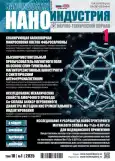Исследование механических свойств аморфного провода Co-сплава 84КХСР переменного диаметра методом инструментального индентирования
- Авторы: Гладких Е.В.1, Султанова Г.Х.1,2, Русаков А.А.1, Усеинов А.С.3, Молоканов В.В.4, Крутилин А.В.4, Палий Н.А.4
-
Учреждения:
- Национальный исследовательский центр "Курчатовский институт" – Технологический институт сверхтвердых и новых углеродных материалов
- Федеральное государственное автономное образовательное учреждение высшего образования "Московский физико-технический институт (национальный исследовательский университет)"
- Федеральное государственное бюджетное учреждение науки "Институт физики высоких давлений им. Л.Ф. Верещагина" Российской академии наук
- Федеральное государственное бюджетное учреждение науки "Институт металлургии и материаловедения им. А.А. Байкова" Российской академии наук
- Выпуск: Том 18, № 1 (2025)
- Страницы: 30-38
- Раздел: Нанотехнологии
- URL: https://journals.eco-vector.com/1993-8578/article/view/679885
- DOI: https://doi.org/10.22184/1993-8578.2025.18.1.30.38
- ID: 679885
Цитировать
Полный текст
Аннотация
Проведено исследование пространственного распределения механических свойств в "толстом" аморфном проводе Со-сплава 84КХСР. Конусный образец аморфного провода переменного диаметра (70–300 мкм) получен методом Улитовского-Тейлора за счет изменения скорости вытяжки в процессе получения провода. После удаления стеклянной оболочки и проведения проверки на соответствие структуры провода аморфному состоянию исследовали механические свойства образцов конусного провода диаметром 100 и 270 мкм методом инструментального индентирования. Установлено, что аморфный провод в интервале диаметров 70–300 мкм сохраняет стабильные значения твердости и модуля упругости в поперечном и продольном сечениях. Механические свойства проводов исследованных диаметров также практически не изменяются при перемещении от центра образцов к краю. Полученные данные свидетельствуют о высокой изотропности аморфной структуры провода переменного диаметра. Отмеченные более высокие значения твердости и модуля упругости в образце диаметром 270 мкм (Н = 9,8 ГПа, Е = 212 ГПа) по сравнению с образцом диаметром 100 мкм (Н = 8,6 ГПа, Е = 163 ГПа) могут быть обусловлены более интенсивным формированием кластерной структуры за счет снижения эффективной скорости охлаждения более "толстого" провода. Отмечено, что такие провода могут найти применение для изготовления новых видов медицинского инструмента.
Ключевые слова
Полный текст
Об авторах
Е. В. Гладких
Национальный исследовательский центр "Курчатовский институт" – Технологический институт сверхтвердых и новых углеродных материалов
Email: useinov@mail.ru
ORCID iD: 0000-0001-8273-3934
к.ф.-м.н., науч. сотр.
Россия, г. Троицк, МоскваГ. Х. Султанова
Национальный исследовательский центр "Курчатовский институт" – Технологический институт сверхтвердых и новых углеродных материалов; Федеральное государственное автономное образовательное учреждение высшего образования "Московский физико-технический институт (национальный исследовательский университет)"
Email: useinov@mail.ru
ORCID iD: 0000-0002-4770-5724
мл. науч. сотр.
Россия, г. Троицк, Москва; г. ДолгопрудныйА. А. Русаков
Национальный исследовательский центр "Курчатовский институт" – Технологический институт сверхтвердых и новых углеродных материалов
Email: useinov@mail.ru
ORCID iD: 0000-0001-5702-1353
мл. науч. сотр.
Россия, г. Троицк, МоскваА. С. Усеинов
Федеральное государственное бюджетное учреждение науки "Институт физики высоких давлений им. Л.Ф. Верещагина" Российской академии наук
Автор, ответственный за переписку.
Email: useinov@mail.ru
ORCID iD: 0000-0002-9937-0954
к.ф.-м.н., зам. дир.
Россия, г. Троицк, МоскваВ. В. Молоканов
Федеральное государственное бюджетное учреждение науки "Институт металлургии и материаловедения им. А.А. Байкова" Российской академии наук
Email: useinov@mail.ru
ORCID iD: 0000-0003-4664-463X
к.т.н., вед. науч. сотр.
Россия, МоскваА. В. Крутилин
Федеральное государственное бюджетное учреждение науки "Институт металлургии и материаловедения им. А.А. Байкова" Российской академии наук
Email: useinov@mail.ru
ORCID iD: 0000-0003-4223-6890
мл. науч. сотр.
Россия, МоскваН. А. Палий
Федеральное государственное бюджетное учреждение науки "Институт металлургии и материаловедения им. А.А. Байкова" Российской академии наук
Email: useinov@mail.ru
ORCID iD: 0000-0002-1334-6014
ст. науч. сотр.
Россия, МоскваСписок литературы
- Qin F., Peng H.X. Ferromagnetic microwires enabled multifunctional composite materials // Progress in Materials Science. 2013. V. 58. No. 2. PP. 183–259.
- Vazquez M. Advanced magnetic microwires // Handbook of Magnetism and Advanced Magnetic Materials, 2007.
- Panina L., Dzhumazoda A., Nematov M. et al. Soft magnetic amorphous microwires for stress and temperature sensory applications // Sensors. 2019. Vol. 19. No. 23. P. 5089.
- Molokanov V.V., Moroz O.V., Krutilin A.V. et al. Fabrication and physicomechanical properties of amorphous microwires and microspirals // Russian Metallurgy (Metally). 2022. Vol. 2022. No. 4. PP. 300–308.
- Kostitsyna E.V., Gudoshnikov S.A., Popova A.V. et al. Mechanical properties and internal quenching stresses in Co-rich amorphous ferromagnetic microwires // Journal of Alloys and Compounds. 2017. Vol. 707. PP. 199–204.
- Ulitovsky A.V., Malanski I.M., Avramenco A.I. Method of continuous casting of glass coated microwire. Patent No. 128427 (USSR). 15.05.60. Bulletin, 10. P. 14.
- Molokanov V.V., Shalygin A.N., Umnov P.P. et.al. Conditions for obtaining "thick" amorphous wires by the Ulitovsky–Taylor method // Inorganic Materials: Applied Research. 2019. Vol. 10. PP. 463–466.
- Алпатов А.А., Молоканов В.В., Крутилин А.В. и др. Протяженные тензорезистивные датчики на основе аморфных микропроводов для контроля состояния конструкций и сооружений // Безопасность и мониторинг природных и техногенных систем. 2023. С. 95–98.
- Zhukova V., Corte León P., Blanco Aranguren J.M. et al. Development of magnetically soft amorphous microwires for technological applications // Chemosensors. 2022. Vol. 10. No. 1.
- Гудошников С.А., Попова А.В., Фатеев В.М. и др. Датчик измерения механических деформаций. RU 2552124 C1. Опубликовано: 10.06.2015. Бюл. № 16.
- Аксенов О.И., Аксенов А.А., Аронин А.С. Датчик измерения механических напряжений на основе микропроводов с положительной магнитострикцией. RU 2746765 C1. Опубликовано: 20.04.2021. Бюл. № 11.
- Молоканов В.В., Алпатов А.А., Крутилин А.В. и др. Мониторинг состояния авиационно-космической техники с использованием тензодатчиков на основе аморфных ферромагнитных микропроводов // Сб. тезисов Международного аэрокосмического конгресса по аэронавтике, 2023. С. 132–134.
- Молоканов В.В., Дубов А.А., Ямчук А.В. и др. Анализ дефектов литых стержней околоэвтектического Cо-сплава до и после зонной плавки // Электрометаллургия. 2024. № 1. С. 16–23.
- Коплак О.В., Дворецкая Е.В., Кравчук К.С. и др. Морфология и механические свойства микропроводов PrDyFeCoB // Физика твердого тела. 2020. Т. 62. № 12. С. 2026–33.
- Усеинов А.С., Кравчук К.С., Гладких Е.В. и др. Измерение механических свойств методом инструментального индентирования в широком диапазоне температур // НАНОИНДУСТРИЯ. 2021. Т. 14. № 2. С. 108–116. https://doi.org/10.22184/1993-8578.2021.14.2.108.116
- BS EN ISO 14577: 2015. Metallic materials. Instrumented indentation test for hardness and materials parameters.
Дополнительные файлы








